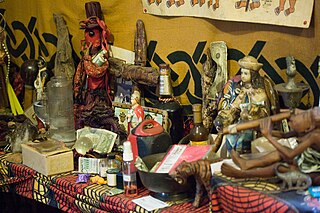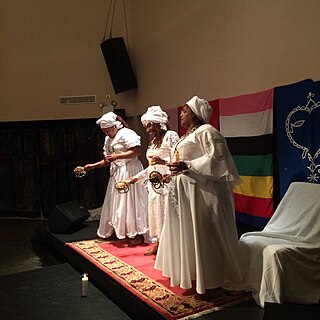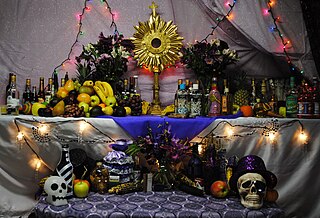Mojo, in the African-American folk belief called hoodoo, is an amulet consisting of a flannel bag containing one or more magical items. It is a "prayer in a bag", or a spell that can be carried with or on the host's body.

Vodun is practiced by the Fon people of Benin, and southern and central Togo; as well in Ghana, and Nigeria.
Spirituals is a genre of songs originating in the United States and created by African Americans. Spirituals were originally an oral tradition that imparted Christian values while also describing the hardships of slavery. Although spirituals were originally unaccompanied monophonic songs, they developed into harmonized choral arrangements.

Candomblé is an Afro-American religion that developed in Brazil during the early 19th century. It arose through a process of syncretism between the traditional Yoruba religion of West Africa and the Roman Catholic form of Christianity. There is no central authority in control of the movement.
Ifá is a Yoruba religion and system of divination. Its literary corpus is the Odu Ifá. Orunmila is identified as the Grand Priest, as he is who revealed divinity and prophecy to the world. Babalawos or Iyanifas use either the divining chain known as Opele, or the sacred palm or kola nuts called Ikin, on the wooden divination tray called Opon Ifá.
The Gullah are African Americans who live in the Lowcountry region of the U.S. states of Georgia, Florida, and South Carolina, in both the coastal plain and the Sea Islands. They developed a creole language, the Gullah language, and a culture rich in African influences that makes them distinctive among African Americans.

African diaspora religions are a number of related religions that developed in the Americas in various nations of the Caribbean, Latin America, and the Southern United States. They derive from traditional African religions with some influence from other religious traditions, notably Christianity.
Evocation is the act of caIIing upon or summoning a spirit, demon, deity or other supernatural agents, in the Western mystery tradition. Comparable practices exist in many religions and magicaI traditions and may empIoy the use of mind-aItering substances with and without uttered word formuIas.
Goofer dust is a traditional hexing material and practice of the African American tradition of hoodoo from the South Eastern region of the United States of America.

Mumbo Jumbo is a 1972 novel by African-American author Ishmael Reed. Mumbo Jumbo has remained in print for 45 years, since its first edition, and has been published in French, Italian, Spanish, Japanese, and British editions, with a Chinese translation currently in production.

The Sixth and Seventh Books of Moses is an 18th- or 19th-century magical text allegedly written by Moses, and passed down as hidden books of the Hebrew Bible. Self-described as "the wonderful arts of the old Hebrews, taken from the Mosaic books of the Kabbalah and the Talmud," it is actually a grimoire, or text of magical incantations and seals, that purports to instruct the reader in the spells used to create some of the miracles portrayed in the Bible as well as to grant other forms of good fortune and good health. The work contains reputed Talmudic magic names, words, and ideograms, some written in Hebrew and some with letters from the Latin alphabet. It contains "Seals" or magical drawings accompanied by instructions intended to help the user perform various tasks, from controlling weather or people to contacting the dead or Biblical religious figures.
Various types of witchcraft and occult religious practices exist in Latin American and Afro-Caribbean cultures, known in Spanish as brujería. Influenced by indigenous religion, Catholicism, and European witchcraft, the purpose may range from benevolent white magic to evil black magic.

A mambo is a priestess in the Haitian Vodou religion. Haitian Vodou's conceptions of priesthood stem from the religious traditions of enslaved people from Dahomey, in what is today Benin. For instance, the term mambo derives from the Fon word nanbo. Like its West African counterpart, Haitian mambos are female leaders in Vodou temples who perform healing work and guide others during complex rituals. This form of female leadership is prevalent in urban centers such as Port-au-Prince. Typically, there is no hierarchy among mambos and houngans. These priestesses and priests serve as the heads of autonomous religious groups and exert their authority over the devotees or spiritual servants in their hounfo (temples). Mambos and houngans are called into power via spirit possession or the revelations in a dream. They become qualified after completing several initiation rituals and technical training exercises where they learn the Vodou spirits by their names, attributes, and symbols. The first step in initiation is lave tèt, which is aimed at the spirits housed in an individual's head. The second step is known as kouche, which is when the initiate enters a period of seclusion. Typically, the final step is the possession of the ason, which enables the mambo or houngan to begin their work. One of the main goals of Vodou initiation ceremonies is to strengthen the mambo's konesans—knowledge that determines priestly power.

Haitian Vodou is an African diasporic religion that developed in Haiti between the 16th and 19th centuries. It arose through a process of syncretism between the traditional religions of West Africa and Roman Catholicism. Adherents are known as Vodouists or "servants of the spirits". Historically decentralized and absent consensus authority, the movement has become more centralized recently, culminated by the 2008 election of Vodou priest Max Beauvoir to the position of Supreme Servitur or Ati, the highest ranking position within the religion.
A black cat bone is a type of lucky charm used in the African American magical tradition of hoodoo. It is thought to ensure a variety of positive effects, such as invisibility, good luck, protection from malevolent magic, rebirth after death, and romantic success.
...Got a black cat bone
got a mojo too,
I got John the Conqueror root,
I'm gonna mess with you...

Gris-gris, is a Voodoo amulet originating in Africa which is believed to protect the wearer from evil or bring luck, and in some West African countries is used as a method of birth control. It consists of a small cloth bag, usually inscribed with verses from an African ancestors containing a ritual number of small objects, worn on the person.

Louisiana Voodoo, also known as New Orleans Voodoo describes a set of spiritual beliefs and practices developed from the traditions of the African diaspora in Louisiana. It is sometimes referred to as Mississippi Valley Voodoo when referring to its historic popularity and development in the greater Mississippi Valley. It is a cultural form of the Afro-American religions developed by the West and Central African populations of the U.S. state of Louisiana. Voodoo is one of many incarnations of African-based spiritual folkways, rooted in West African Dahomeyan Vodun.

Christian-Vodou relations have been marked by syncretism and conflicts, especially in Haiti, but less so in Louisiana and elsewhere.

Haint blue is a collection of pale shades of blue-green that are traditionally used to paint porch ceilings in the southern United States.













